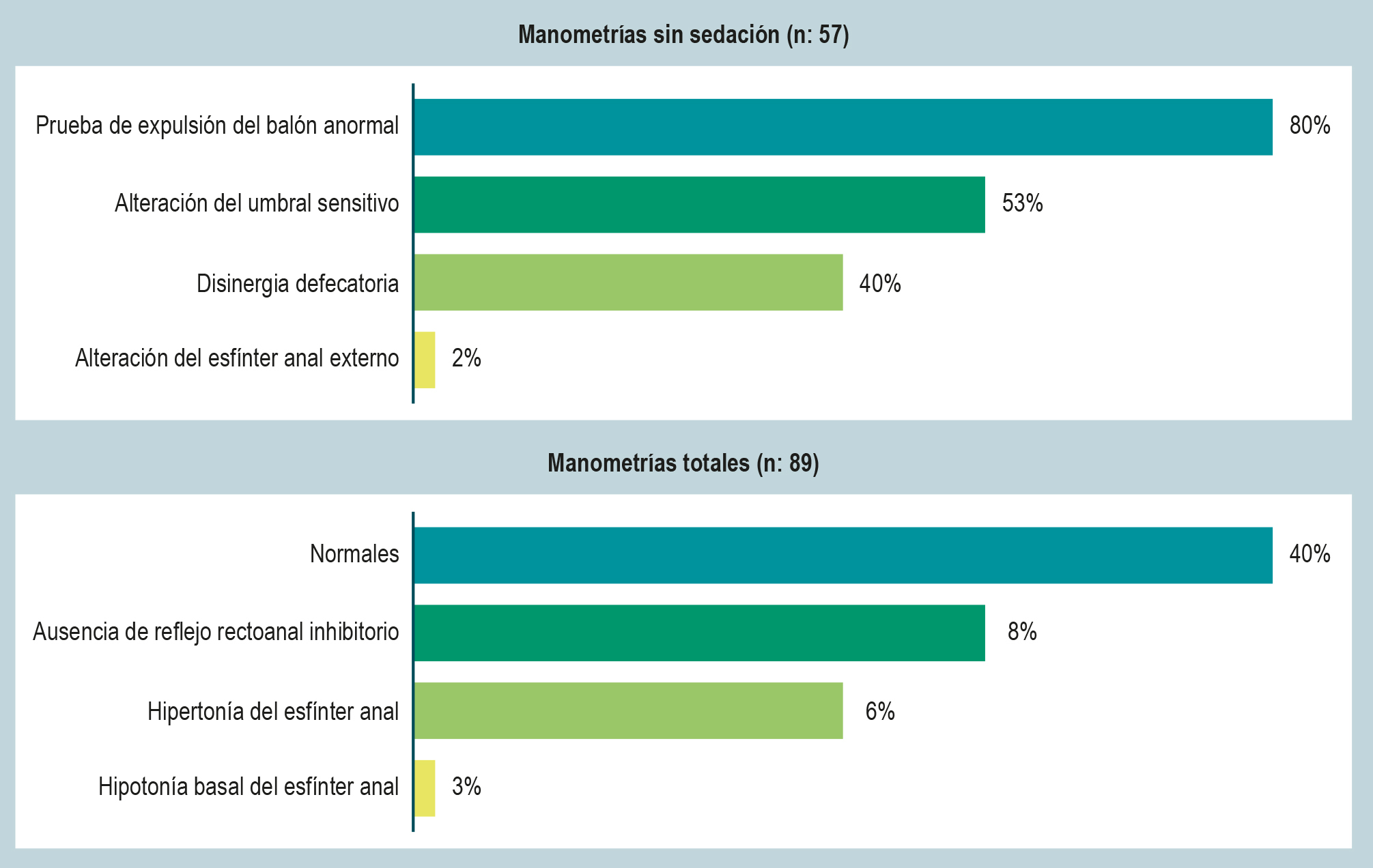Auditando trastornos manométricos anorrectales en niños con estreñimiento en un hospital de Colombia
DOI:
https://doi.org/10.22516/25007440.1195Palabras clave:
Estreñimiento, Manometría, Pediatría, Motilidad gastrointestinalResumen
Introducción y objetivos: los trastornos anorrectales pueden ser una causa subyacente de estreñimiento crónico refractario en pediatría. Este estudio tiene como objetivo identificar dichos trastornos mediante el uso de manometría anorrectal de alta resolución (MAR-AR) en niños que padecen estreñimiento crónico refractario.
Materiales y métodos: se llevó a cabo un estudio observacional descriptivo retrospectivo de corte transversal de exploración de datos basado en las MAR-AR realizadas en menores de 18 años con estreñimiento crónico refractario en un hospital en Colombia durante el período comprendido entre 2014 y 2018. Se realizó un análisis descriptivo exploratorio de variables demográficas y parámetros de manometría, y además se compararon diagnósticos manométricos convencionales y se homologaron con la clasificación de Londres.
Resultados: se evaluó a 89 pacientes y, según la clasificación convencional, el 60% de los pacientes tenían anormalidades en la manometría y el 8% no tenían reflejo rectoanal inhibitorio (RRAI). En 57 pacientes se realizó la manometría sin sedación, de los cuales el 80% tenían prueba de expulsión del balón (TEDB) anormal; el 53%, alteración del umbral sensitivo, y el 40%, disinergia defecatoria. Se extrapoló la clasificación de Londres y se obtuvo que el 93% tenían desórdenes en sensibilidad rectal; el 84%, desórdenes de la coordinación rectoanal; el 39%, trastorno del tono y la contractilidad, y el 11%, arreflexia rectoanal.
Conclusiones: los trastornos anorrectales son frecuentes en el estreñimiento crónico refractario en niños, y se diagnostican mediante MAR-AR para establecer pronósticos y tratamientos dirigidos, como en el caso de las disinergias. Una clasificación similar a la de Londres con valores manométricos establecidos para la población pediátrica por grupos de edades permitiría un enfoque sistemático y complementario al enfoque tradicional y aumentaría la sensibilidad diagnóstica.
Descargas
Referencias bibliográficas
Koppen IJN, Di Lorenzo C, Saps M, Dinning PG, Yacob D, Levitt MA, et al. Childhood constipation: finally something is moving! Expert Rev Gastroenterol Hepatol. 2016;10(1):141-155. https://doi.org/10.1586/17474124.2016.1098533
Mugie SM, Di Lorenzo C, Benninga MA. Constipation in childhood. Nature Rev Gastroenterol Hepatol. 2011;8(9):502-511. https://doi.org/10.1038/nrgastro.2011.130
Remes Troche JM, Chávez Barrera JA, Worona Dibner LB. Guidelines for diagnosis and treatment of constipation in Mexico. D) Evaluation and treatment of constipation in pediatric population. Rev Gastroenterol Mexico. 2011;76(2):155-168.
Rajindrajith S, Devanarayana NM, Crispus Perera BJ, Benninga MA. Childhood constipation as an emerging public health problem. World J Gastroenterol. 2016;22(30):6864-6875. https://doi.org/10.3748/wjg.v22.i30.6864
Saps M, Nichols-Vinueza DX, Rosen JM, Velasco-Benítez CA. Prevalence of functional gastrointestinal disorders in Colombian school children. J Pediatr. 2014;164(3):542-545.e1. https://doi.org/10.1016/j.jpeds.2013.10.088
Madani S, Tsang L, Kamat D. Constipation in Children: A Practical Review. Pediatr Ann. 2016;45(5):e189-196. https://doi.org/10.3928/00904481-20160323-01
Tabbers MM, DiLorenzo C, Berger MY, Faure C, Langendam MW, Nurko S, et al. Evaluation and treatment of functional constipation in infants and children: evidence-based recommendations from ESPGHAN and NASPGHAN. J Pediatr Gastroenterol Nutr. 2014;58(2):258-274. https://doi.org/10.1097/MPG.0000000000000266
Hasosah M. Chronic refractory constipation in children: think beyond stools. Global Pediatric Health 2021;8:2333794X211048739. https://doi.org/10.1177/2333794X211048739
Tambucci R, Quitadamo P, Thapar N, Zenzeri L, Caldaro T, Staiano A, et al. Diagnostic Tests in Pediatric Constipation. J Pediatr Gastroenterol Nutr. 2018;66(4):e89-e98. https://doi.org/10.1097/MPG.0000000000001874
Athanasakos E, Cleeve S, Thapar N, Lindley K, Perring S, Cronin H, et al. Anorectal manometry in children with defecation disorders BSPGHAN Motility Working Group consensus statement. Neurogastroenterol Motil. 2020;32(6):e13797. https://doi.org/10.1111/nmo.13797
Delgado AF, Barney VAC, de Ardila ACH, Naranjo AML, Hani AFA, Madrid DMM. Actualización con la clasificación de Londres en la interpretación de la manometría anorrectal de alta resolución. Rev Colomb Gastroenterol. 2019;34(4):411-415. https://doi.org/10.22516/25007440.484
Lee YY, Erdogan A, Rao SS. High resolution and high definition anorectal manometry and pressure topography: diagnostic advance or a new kid on the block? Curr Gastroenterol Rep. 2013;15(12):360. https://doi.org/10.1007/s11894-013-0360-2
Rocca A, Chávez JA, Ditaranto A, Falcon AC, Mortarini A, Neder D, et al. Estudios de motilidad en pediatría: aspectos técnicos, indicaciones y limitaciones en los niños. NeuroGastroLatam Rev. 2022;6(3):164-180. https://doi.org/10.24875/NGL.22000022
Rodriguez L, Sood M, Di Lorenzo C, Saps M. An ANMS‐NASPGHAN consensus document on anorectal and colonic manometry in children. Neurogastroenterol Motil. 2017;29(1):e12944. https://doi.org/10.1111/nmo.12944
Banasiuk M, Banaszkiewicz A, Dziekiewicz M, Załęski A, Albrecht P. Values from three-dimensional high-resolution anorectal manometry analysis of children without lower gastrointestinal symptoms. Clin Gastroenterol Hepatol. 2016;14(7):993-1000. https://doi.org/10.1016/j.cgh.2016.01.008
Carrington EV, Heinrich H, Knowles CH, Fox M, Rao S, Altomare DF, et al. The international anorectal physiology working group (IAPWG) recommendations: Standardized testing protocol and the London classification for disorders of anorectal function. Neurogastroenterol Motil. 2020;32(1):e13679. https://doi.org/10.1111/nmo.13679
Dinning PG, Carrington EV, Scott SM. The use of colonic and anorectal high-resolution manometry and its place in clinical work and in research. Neurogastroenterol Motil. 2015;27(12):1693-1708. https://doi.org/10.1111/nmo.12632
Tuduri Limousin I, Cabo Valdés JA, Moya Jiménez MJ, Granero Cendón R, Fernández Pineda I, Cabrera García R, et al. Fiabilidad de la manometría anorrectal para el diagnóstico de la enfermedad de Hirschsprung en neonatos: experiencia de 25 años. Cir Pediátr. 2008;21(4):232-4.
Keshtgar AS, Ward HC, Clayden GS. Pathophysiology of chronic childhood constipation: functional and morphological evaluation by anorectal manometry and endosonography and colonic transit study. J Pediatr Surg. 2013;48(4):806-812. https://doi.org/10.1016/j.jpedsurg.2012.08.037
Tran K, Kuo B, Zibaitis A, Bhattacharya S, Cote C, Belkind-Gerson J. Effect of propofol on anal sphincter pressure during anorectal manometry. J Pediatr Gastroenterol Nutr. 2014;58(4):495-497. https://doi.org/10.1097/MPG.0000000000000190
Sharma A, Herekar A, Yan Y, Karunaratne T, Rao SSC. Dyssynergic Defecation and Other Evacuation Disorders. Gastroenterol Clin North Am. 2022;51(1):55-69. https://doi.org/10.1016/j.gtc.2021.10.004
García-Valencia OA, Sánchez-Ávila MT, Martínez-Ordaz L, Hernández-Flores I, Moreno Medrano E, Morales-Garza LA, et al. Características manométricas en niños con estreñimiento crónico y patología anorrectal adquirida. Rev Gastroenterol Perú. 2019;39(2):136-140.
Zhao Y, Ren X, Qiao W, Dong L, He S, Yin Y. High-resolution Anorectal Manometry in the Diagnosis of Functional Defecation Disorder in Patients With Functional Constipation: A Retrospective Cohort Study. J Neurogastroenterol Motil. 2019;25(2):250-257. https://doi.org/10.5056/jnm18032
Alessandrella A, Turco R, Russo M, Poziello A, Miele E, Staiano A. High-resolution anorectal manometry in children with functional constipation with or without fecal incontinence. Neurogastroenterol Motil. 2020;32(9):e13882. https://doi.org/10.1111/nmo.13882
Fathy A, Megahed A, Barakat T, Abdalla AF. Anorectal functional abnormalities in Egyptian children with chronic functional constipation. Arab J Gastroenterol. 2013;14(1):6-9. https://doi.org/10.1016/j.ajg.2013.02.001
El-Shabrawi M, Hanafi HM, Abdelgawad MMAH, Hassanin F, Mahfouze AAA, Khalil AFM, et al. High-resolution anorectal manometry in children with functional constipation: a single-centre experience before and after treatment. Prz Gastroenterol. 2018;13(4):305-312. https://doi.org/10.5114/pg.2018.79810

Descargas
Publicado
Cómo citar
Número
Sección
Licencia
Derechos de autor 2024 Revista colombiana de Gastroenterología

Esta obra está bajo una licencia internacional Creative Commons Atribución-NoComercial-SinDerivadas 4.0.
Aquellos autores/as que tengan publicaciones con esta revista, aceptan los términos siguientes:
Los autores/as ceden sus derechos de autor y garantizarán a la revista el derecho de primera publicación de su obra, el cuál estará simultáneamente sujeto a la Licencia de reconocimiento de Creative Commons que permite a terceros compartir la obra siempre que se indique su autor y su primera publicación en esta revista.
Los contenidos están protegidos bajo una licencia de Creative Commons Reconocimiento-NoComercial-SinObraDerivada 4.0 Internacional.


















